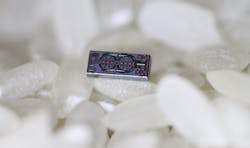Silicon-Based Electro-Optical Gyroscope Overcomes SNR Deficiencies
Those tiny gyroscopes—along with accelerometers, they’re the foundation of inertial guidance—keep getting better. The mechanical spinning-wheel and laser-based optical gyro have been supplanted in most applications by fiber-optic and MEMS gyros, but the latter pair have difficulties reaching the precision performance of the former. Attempts to miniaturize the fiber gyro have fallen short due to second- and third-order errors that result from thermal fluctuations, component drift, and fabrication mismatch brought on by signal-to-noise ratio (SNR) degradation as size and optical-path length shrinks.
Engineers know that intrinsic errors in systems can be reduced by using techniques such as upfront or ongoing calibration. They minimize the sources of the errors through ever-better components and materials, and—perhaps the best technique where feasible—devise an architecture that causes the errors to self-cancel. Applying that last principle, a team at Caltech funded by the Rothenberg Innovation Initiative has devised, built, and tested a new approach to tiny, silicon-based electro-optical gyros that provides precision performance with little cost or other negatives (Fig. 1).
1. This electro-optical nano-gyroscope devised at Caltech measures just 2 mm on each side, yet provides excellent performance due to a technique that enables cancellation of a major source of errors. (Source: Ali Hajimiri/Caltech)
Their solution leverages what they denote as the “reciprocity” of passive optical networks to greatly reduce thermal fluctuations and mismatch, and thus yield superior results compared to previous approaches. Their demonstration device is capable of detecting phase shifts—a primary figure of merit for these units—that are 30 times smaller than state-of-the-art, miniature fiber-optic gyroscopes, even though the unit itself is 500 times smaller. The overall improvement in performance of optical gyroscopes is one to two orders of magnitude.
As published in Nature, their paper “Nanophotonic optical gyroscope with reciprocal sensitivity enhancement” explains the approach, which is somewhat analogous to using differential signals to cancel common-mode electrical signals. As with all optical gyros, their device uses the relativistic Sagnac effect to determine angular velocity, by measuring the relative phase-shifting between two counterrotating optical waves (one as a reference path, the other as signal path) created via a beam splitter from a single source. These are then recombined after their transit. When the reference frame of the gyroscope is rotating, the effective path lengths as seen by the two beams change, and thus fringing occurs between the light beams at the receiving-end sensors.
Overall performance is normally closely linked to the path length, with a longer path offering greater precision and less sensitivity to dynamic differences between the two paths. Miniaturizing the path by using a waveguide in a silicon substrate rather than lengths of optical fibers or a vacuum path means increased sensitivity to any path-related changes.
2. The optical gyro and the Sagnac effect: The silicon nanophotonic waveguide supports a single mode at 1550 nm (a); rotation of the ring induces a phase difference between the two counterrotating waves (b); in the reciprocal sensitivity enhancement technique, the incoming signal is switched between the red path (clockwise propagation) and the blue path (anticlockwise propagation). (Source: Ali Hajimiri/Caltech)
To work around this issue, the Caltech team set used a design that continually alternates the optical paths (Fig. 2) at a rate much higher than any fluctuations. The “polarity” of the signals that travel through the silicon’s optical waveguides is reversed, while undesirable common-mode components such as thermal-based fluctuations and mismatch, are attenuated. In this context, "reciprocal" means that both beams of light within the gyroscope optical waveguides are affected in the same way by imperfections.
The overall design uses a significant amount of electronics, of course, including a pair of channels comprised of photodiodes, transimpedance amplifiers (TIAs), and variable gain amplifiers (VGAs), plus low-pass filtering and demodulation (Fig. 3).
3. The input Mach-Zehnder interferometer used for path switching and the measured power in each direction versus injected current into one of the photodiodes (a). A schematic of the implemented nano-optical gyro (b). The optical signals are each captured by a photodiode, and amplified by a TIA and VGA signal chain, then added together and multiplied by the reference frequency through a passive mixer to extract the amplitude information that encodes the rate of rotation (c). (Source: Ali Hajimiri/Caltech)
The all-integrated optical gyroscope device fabricated by the researchers, headed by Ali Hajimiri, Bren Professor of Electrical Engineering and Medical Engineering in the Division of Engineering and Applied Science at Caltech, measures just 2 × 2 mm. The team maintains that their reciprocal sensitivity approach has greater benefits and much lower complexity than alternatives such as using a non-coherent light source, or employing a low-loss waveguide (which usually requires different, harder-to-fabricate optical-waveguide core and clad materials). Further, it enables detection of the smallest recorded phase-shift (just 3 nanoradians) of all miniaturized approaches implemented in silicon nanophotonics thus far.
About the Author

Bill Schweber
Contributing Editor
Bill Schweber is an electronics engineer who has written three textbooks on electronic communications systems, as well as hundreds of technical articles, opinion columns, and product features. In past roles, he worked as a technical website manager for multiple topic-specific sites for EE Times, as well as both the Executive Editor and Analog Editor at EDN.
At Analog Devices Inc., Bill was in marketing communications (public relations). As a result, he has been on both sides of the technical PR function, presenting company products, stories, and messages to the media and also as the recipient of these.
Prior to the MarCom role at Analog, Bill was associate editor of their respected technical journal and worked in their product marketing and applications engineering groups. Before those roles, he was at Instron Corp., doing hands-on analog- and power-circuit design and systems integration for materials-testing machine controls.
Bill has an MSEE (Univ. of Mass) and BSEE (Columbia Univ.), is a Registered Professional Engineer, and holds an Advanced Class amateur radio license. He has also planned, written, and presented online courses on a variety of engineering topics, including MOSFET basics, ADC selection, and driving LEDs.




